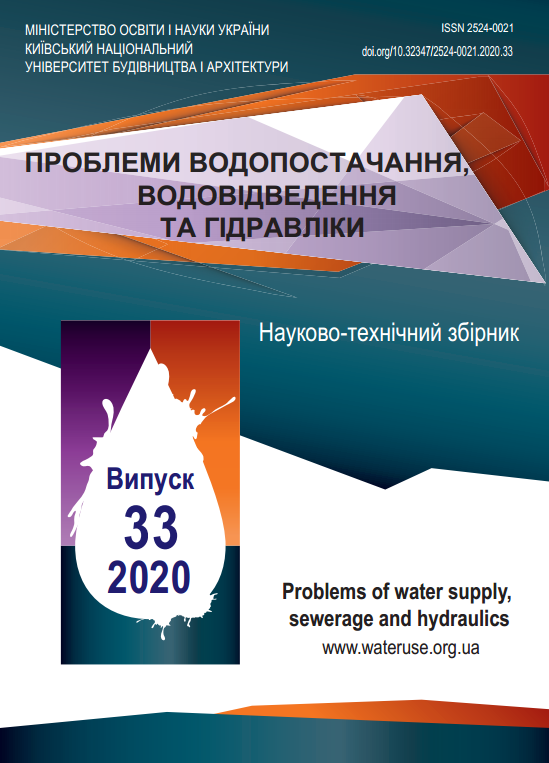Improvement of certain elements of pressure flotation cleaning complex
DOI:
https://doi.org/10.32347/2524-0021.2020.33.4-10Ключові слова:
pressure flotation, saturator, tubular saturatorАнотація
A number of improvements to the existing schemes of pressure and flotation treatment of industrial wastewater are proposed. The classical variant of the organization of the scheme of pressure flotation with compressor injection of air into the vertical saturator and the system with the horizontal tubular saturator were considered. For the classical scheme the variant of full refusal of the compressor due to use of possibility of the pump to suck atmospheric air through the separate device on type of a rotameter together with working liquid from accumulative capacity is offered. Such changes will significantly reduce capital costs due to the price of the compressor and operating costs due to the corresponding consumption of electricity by the compressor. Given the disadvantages of the tubular saturator, an option is proposed that will preserve the advantages of the horizontal location of the tank for dissolving air in water and at the same time guarantees the possibility of undissolved atmospheric air entering the floater, as can happen in a vertical saturator. The saturation system consists of several separate tubular elements, located with a slope of 0.002… 0.005 on the movement of the liquid and mounted on a common frame. This design of the air saturation system in the working fluid makes it possible to avoid the danger of breaking undissolved air directly into the flotator.Посилання
Fanaie, V. R., Khiadani, M., & Sun, G., (2019). Effect of salinity and temperature on air dissolution in an unpacked air saturator of a dissolved air flotation system. Desalination and Water Treatment, 170, doi:10.5004/dwt.2019.24718
Barbery, G., (1984) Engineering Aspects of Flotation in the Minerals Industry: Flotation Machines, Circuits and their Simulation. In K. J. Ives (Ed.) The Scientific Basis of Flotation. NATO ASI Series (Series E: Applied Sciences). Dordrecht: Springer. doi:10.1007/978-94-009-6926-1_8
Medyanik, N. L., Shevelin, I. Yu., & Kakushkin, S. N. (2018). Mathematical Modeling of Mineralized Industrial Wastewater Treatment by Pressure Flotation. Physical and technical problems of mineral development, 2, 121-129, doi: 10.15372/FTPRPI20180213
Nironovich, N. I., Tretyak, I. Y., & Kopytin, A. M. (2017). Pressure flotation as one of the most effective methods of pre-treatment of industrial effluents. Water supply, drainage, 4, 45-47.
Parshilkina, A. A., (2014). Choice of a method for purifying waste water from a fish processing enterprise. Izvestia KSTU, 34, 156-164. [in Russian]
Nebesnova, T. V., & Tsygankova, O. V. (2011). Analysis of the designs of modern flotation units. Visnik ODABA, 40, Retrieved from http://mx.ogasa.org.ua/handle/123456789/1232
Ostapyuk, V. A. (2013). Wastewater treatment technology by flotation using a pipe saturator. SGASU Bulletin. Urban planning and architecture, 4(13), 57-62. [in Russian]
Voronov, Yu. V., & Yakovlev, S. V., (2006). Water drainage and wastewater treatment. Moscow: Publishing House of the Association of Construction Universities. [in Russian]
Gusyak, A. M., Znak, Z. O., Kurylets, O. G., Mnykh, R. V., Olenych, R. R., & Savchuk, L. V. (2013). Method of wastewater treatment by pressure flotation. Utility model patent № 85950, Retrieved from https://uapatents.com/4-85950-sposib-ochishhennya-stichnikh-vod-napirnoyu-flotaciehyu.html
Tavartkiladze, Yu. M., & Ostapyuk, V. A. (2013). Installation "Floater with tubular saturator". Utility model patent № 79440. Retrieved from http://uapatents.com/6-79440-ustanovka-flotator-z-trubchatim-saturatorom.html
##submission.downloads##
Опубліковано
Як цитувати
Номер
Розділ
Ліцензія
Автори, які публікуються у цьому журналі, погоджуються з наступними умовами:
a) Автори залишають за собою право на авторство своєї роботи та передають журналу право першої публікації цієї роботи, яка через 70 років після смерті останнього співавтора з дати публікації автоматично стає доступною на умовах ліцензії Creative Commons Attribution License, котра дозволяє іншим особам вільно розповсюджувати опубліковану роботу з обов'язковим посиланням на авторів оригінальної роботи та першу публікацію роботи у цьому журналі.
b) Автори мають право укладати самостійні додаткові угоди щодо неексклюзивного розповсюдження роботи у тому вигляді, в якому вона була опублікована цим журналом (наприклад, розміщувати роботу в електронному сховищі установи або публікувати у складі монографії), за умови збереження посилання на першу публікацію роботи у цьому журналі.
c) Політика журналу дозволяє і заохочує розміщення авторами в мережі Інтернет (наприклад, у сховищах установ або на особистих веб-сайтах) рукопису роботи, як до подання цього рукопису до редакції, так і під час його редакційного опрацювання, оскільки це сприяє виникненню продуктивної наукової дискусії та позитивно позначається на оперативності та динаміці цитування опублікованої роботи (див. The Effect of Open Access).


